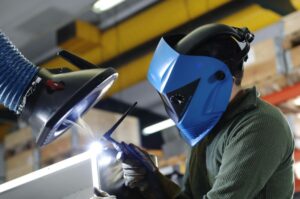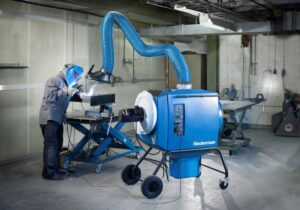Daniel Frith, Operations Manager at UK safety company, Arco, answers questions about the dangers of exposure to airborne contaminants and how to mitigate the risks.
 How can workers be exposed to airborne contaminants?
How can workers be exposed to airborne contaminants?
Airborne contaminants can occur from a variety of outputs depending on the occupational setting via substances such as dust, gases, fumes, mists, or vapours present in the air.
As a result, some industries are more susceptible to the presence of harmful substances such as construction, manufacturing, and mining. Manufacturing roles such as brick and tile manufacture, ceramics and stone working and foundry work are particularly prone to harmful effects.
Even dusts created by foodstuffs that we consider to be safe can be hazardous, if there is continuous exposure. Output is often invisible to the naked eye, and workers are not aware that they are exposed.
What are the dangers of being exposed to these kinds of hazardous substances?
Every year, thousands of workers in the UK experience damaging lung-related effects from airborne contaminants such as lung cancer, asthma or lung scarring because of airborne contaminants they have breathed in at work. In 2022, there was an estimated 19,000 new cases of breathing or lung problems made worse by work, according to the HSE. The severity of harmful effects will ultimately depend on duration, frequency and degree of exposure to the substances.
Further reading: Woodworking businesses targeted on HSE inspections to tackle occupational lung disease
Is it difficult to control exposure to airborne contaminants?
As a result of the variety of airborne contaminant transmission and the often-imperceptible output, the HSE has identified a concerning trend: that employers are often unaware that their workers are being exposed to hazardous substances or that their existing controls may be insufficient.
This lack of awareness gives rise to several issues including the sources of exposure being missed, the deterioration of existing controls and incorrect utilisation of the implemented safeguards.
What is the law on protecting workers from harmful exposure?
The UK has a strong framework and reputation when it comes to health and safety and the approach towards airborne contaminants is no exception.
The primary legislation that addresses harmful airborne contaminants in the workplace is the Control of Substances Hazardous to Health Regulations (COSHH) which outlines that employers have a legal duty to access risks associated with hazardous substances and make decisions on what measures to use to protect the health of their employees. It is important that employers are engaged with airborne hazard safety not only for the health of their employees but to also avoid enforcement action.
What do employers need to do to eliminate the risk and protect workers?
Employers can use the Hierarchy of Control as a way to determine which actions are most necessary to control hazards in the workplace. The first level of control is the elimination of the hazard entirely – removing a toxic chemical for example.
The second level is substitution and involves offering a safer alternative to the hazardous substance. The first two actions can be the most difficult to adopt for reasons such as cost and design and so the third level – local exhaust ventilation systems (LEV) – is the level of control used most often. The use of LEV isolates workers from the hazard by removing the substance at the source. The fourth level is administrative controls such as reducing the frequency of exposure to hazards. The fifth and final level is the use of personal protection equipment (PPE) such as gloves and masks to minimise exposure to hazards. Levels four and five are useful actions but should be combined with other control methods to offer the most protection.
What is the process for installing LEV in the workplace?
 There is a systematic approach to installing LEV in the workplace to make sure that it is fit for purpose and effective. All LEV systems must comply with the Health and Safety at Work Act 1974 (HSWA) and the Control of Substances Hazardous to Health Regulations 2002 (COSHH).
There is a systematic approach to installing LEV in the workplace to make sure that it is fit for purpose and effective. All LEV systems must comply with the Health and Safety at Work Act 1974 (HSWA) and the Control of Substances Hazardous to Health Regulations 2002 (COSHH).
You must manage LEV risk assessment properly; it is advisable that you engage with an expert throughout this process so that the most suitable methods are chosen – installing an ineffective system can be very costly.
We can offer risk assessment guidance and support to help you to identify workplace hazards and implement practical measures to eliminate or reduce them. Without air monitoring, it is impossible to understand how much contaminants are in the air. Arco can provide workplace air monitoring to help identify hazardous substances, evaluate the usage risks, determine the required control measures and ensure that they are working effectively.
How often do LEV systems need to be monitored and checked?
Regular inspections of LEV systems should take place to ensure the smooth running of the device. A Periodic Test Examination (TExT) should be conducted at least every 14 months with records kept for at least five years.
Depending on the age of the system, the amount of wear and tear and whether there have been any changes to the system or processes, more frequent testing may be needed. Additionally, there are certain specified processes requiring even more frequent testing of associated LEV (COSHH Regulations Schedule 4). Business owners should work with an expert safety partner to ensure systems are compliant.
What makes us susceptible to burnout?
In this episode of the Safety & Health Podcast, ‘Burnout, stress and being human’, Heather Beach is joined by Stacy Thomson to discuss burnout, perfectionism and how to deal with burnout as an individual, as management and as an organisation.
We provide an insight on how to tackle burnout and why mental health is such a taboo subject, particularly in the workplace.

 How can workers be exposed to airborne contaminants?
How can workers be exposed to airborne contaminants? There is a systematic approach to installing LEV in the workplace to make sure that it is fit for purpose and effective. All LEV systems must comply with the Health and Safety at Work Act 1974 (HSWA) and the
There is a systematic approach to installing LEV in the workplace to make sure that it is fit for purpose and effective. All LEV systems must comply with the Health and Safety at Work Act 1974 (HSWA) and the 